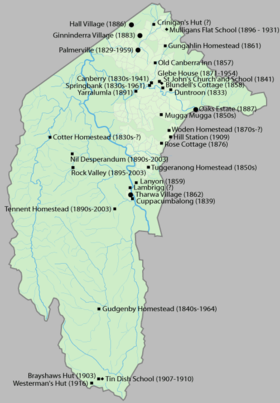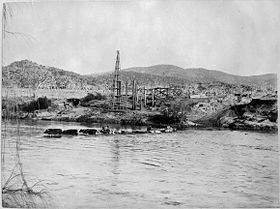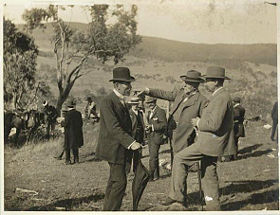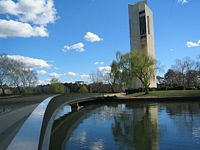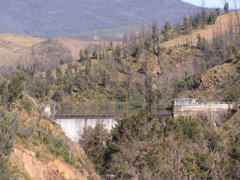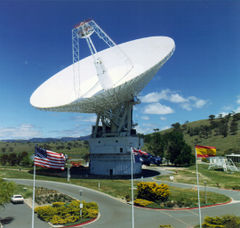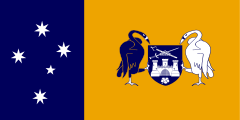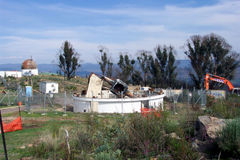History of the Australian Capital Territory
2008/9 Schools Wikipedia Selection. Related subjects: History
| This article is part of the series History of Australia |
| States and Territories |
| New South Wales |
| Victoria |
| Queensland |
| Western Australia |
| South Australia |
| Tasmania |
| Australian Capital Territory |
| Northern Territory |
The history of the Australian Capital Territory as a Territory of Australia began after the Federation of Australia in 1901, when it was created in law as the site for Australia's capital city Canberra. The region has a long prior history of human habitation before the Territory's creation, however, with evidence of Indigenous Australian settlement dating back at least 21,000 years. The region formed the traditional lands associated with the Ngunnawal people and several other linguistic groups, an association known through both early European settler accounts and the oral histories of the peoples themselves. Following the colonisation of Australia by the British, the 19th century saw the initial European exploration and settlement of the area and their encounters with the local indigenous peoples, beginning with the first explorations in 1820 and shortly followed by the first European settlements in 1824. At the outset the region was dominated by large properties used for sheep and cattle grazing, which had been granted to free settlers that had arrived in Australia from the United Kingdom and other European countries. These large properties would later be broken up and subdivided in accordance with changes to land tenure arrangements, smaller farms and urban developments becoming more common.
In the early 20th century, the development of the region took an unusual turn when it was chosen as the site for the creation of Australia's capital city in 1908. The Territory was formally ceded to the Government of Australia by the Government of New South Wales in 1909 and additional land at Jervis Bay was also surrendered to the Commonwealth for the establishment of a sea port for the capital. It officially came under government control as the Federal Capital Territory on January 1, 1911. The planning and construction of Canberra followed, with the Parliament of Australia finally moving there in 1927. The Territory officially became the Australian Capital Territory in 1938. The city of Canberra developed and expanded to accommodate the Australian federal government, while the surrounding area has been developed to support the city, including the construction of dams, the establishment of plantation forests and the creation of protected areas. The political development of the Territory began in 1949, when it was given its first representative in the Parliament of Australia, and was completed when it became an autonomous territory when self-government was granted in 1988.
Prehistory
The lands incorporated by the Australian Capital Territory have long been inhabited by indigenous Australian peoples. Archæological evidence from the Birrigai rock shelter in Tidbinbilla Nature Reserve indicates habitation dating back at least 21,000 years. It is possible that the area had been inhabited for considerably longer, with evidence of Aboriginal presence in south-western New South Wales dating to around 40,000–62,000 years ago. Other sites of significance in the reserve include the Bogong Rocks shelter, which contains the oldest evidence of Aboriginal occupation at a bogong moth resting site. Bogong moths were an important source of food for the Aboriginal peoples of the Southern Alps; the moths would collect in their thousands in caves and rock crevices where they were collected and later roasted in sand or ashes and eaten whole. Numerous other culturally significant and archæologically notable sites are known across the Territory, including shelters, rock art sites, stone artefact scatters, scarred trees and chert quarries. Tidbinbilla Mountain is also believed to have long been used for Aboriginal initiation ceremonies.
Known indigenous Australian groups whose traditional lands lay within the Territory predominantly include the Ngunnawal people, whose association with the area is known through both early European settler accounts and the oral histories of the people themselves. Other groups known to have been active in the region include the Walgalu, and in the surrounding areas the Ngarigo to the south-east of the ACT, the Gundungurra associated with lands to the north, the Yuin on the south coast of New South Wales and the Wiradjuri to the west. These indigenous Australian groups were hunter-gatherers, whose oral traditions maintained and explained their connections with the landscape, the cultural significance of particular features, and their account of their historical identities. However, many of these traditions are only poorly documented, if at all, and apart from what can be reconstructed from evidence obtained from remaining archæological sites, there is no comprehensive record of the history of the local indigenous peoples prior to European exploration and settlement.
Exploration
In 1788 the British landed at Sydney Cove, and the European settlement of Australia began. As the colony expanded more land was needed to grant to free settlers for farming. Governor Lachlan Macquarie supported expeditions to open up new lands to the south, including one to find an overland route from Sydney to Jervis Bay, an area which would later be incorporated into the Territory as its only coastal possession. In 1818 Charles Throsby, Hamilton Hume, James Meehan and William Kearns set out to find that route, a task accomplished that same year by Throsby and Kearns. The 1820s saw further exploration in the Canberra area, associated with the construction of a road from Sydney to the Goulburn plains, supervised by Throsby. Hearing about rivers in the south from the local Aborigines, in 1820 Throsby, his convict assistant Joseph Wild and James Vaughan set off to explore the Canberra region (which they described as the Limestone Plains), also discovering the Yass River. A second expedition was mounted, and Charles Throsby's nephew Charles Throsby Smith, Wild and Vaughan further explored the Molonglo and Queanbeyan Rivers and were the first Europeans to camp at the site of the future National Capital. In 1821 Charles Throsby mounted a third expedition and found the Murrumbidgee River.
Joseph Wild was employed by Brigade Major John Ovens and Captain Mark Currie in 1823 to guide them to the Murrumbidgee. They travelled south along the river and named the area now known as Tuggeranong Isabella's Plain. Unable to cross the river near the current site of Tharwa, they continued on to the Monaro Plains. The last expedition in the region was undertaken by Allan Cunningham in 1824. Cunningham's reports verified that the region was suitable for grazing, and the settlement of the Limestone Plains followed immediately thereafter.
European settlement
When the limits of location for settlement in New South Wales were determined, the Limestone Plains were authorised for settlement by British settlers and settlers of other European origins. The first land grant in the area was made to Joshua John Moore in 1823, and European settlement in the area began in 1824 with the construction of a homestead, on what is now the Acton peninsula, by stockmen employed by him. Moore formally purchased the site in 1826 and named the property Canberry, or Canberra, although he never visited the site. His 4 km² claim covered much of the future North Canberra. Adjacent to the eastern boundary on Moore's claim was land occupied by James Ainslie on behalf of Robert Campbell, which was known as Duntroon. John Palmer was granted land in the region which was taken up by his son George Palmer in 1826. He established Palmerville near Ginninderra Creek in 1829, and the "Squire" at Gungahlin was completed in 1861. Ginninderra Village was the site of first school, which operated from 1844 to 1848. The region's second school opened at Duntroon, adjacent St John's Church. St John's was Canberra's first church; it was consecrated and opened for use in 1845.
The south-west of the Territory, the area known today as Tuggeranong, was settled in the late 1820s, officially beginning with Peter Murdoch in 1827. The Waniassa Homestead (also known as Tuggeranong Homestead) was completed in 1836 by John McQuoid, and the first buildings of the Lanyon estate, owned by John Lanyon and James Wright, were built in 1838. Tharwa was settled in 1834; the homestead in this area was named Cuppacumbalong, and was established by James Wright in 1839. Tharwa is the oldest official settlement in the Australian Capital Territory, having being proclaimed in 1862.
Further south into the area that is now a part of the Namadgi National Park. The Naas and Orroral stations in the Naas and Orroral river valleys were built in 1836. During the 1830s Garret Cotter inhabited the Cotter Valley; the Cotter River received its name by association. From the late 1830s, the Boboyan Homestead and station were established. Gudgenby was settled in the early 1840s; the Gudgenby Homestead was also built around this time. By 1848 most of the major valleys of the Namadgi area had been settled.
During the first 20 years of European settlement, there was only limited contact between the settlers and Aborigines, and reported acts of hostility were minimal, however there were some recorded confrontations. Joseph Franklin purchased land in the Brindabellas in 1849 and attempted to set up a cattle farm. His livestock was slaughtered by the local Aboriginals and he was driven back out of the mountains. In 1859 gold was discovered at Kiandra, the resulting rush of prospectors into the area through the Brindabellas and the mountains to the west of the ACT leading to the further decimation of the Aboriginal population. By the time Franklin returned to the Brindabellas in 1863, such Aboriginal communities as could still be found were few in number and widely dispersed.
As the encroachment of European settlement continued, numbers of surviving Aboriginal families were drawn to the farms and townships by the opportunity to work or receive handouts of food and blankets. Over the succeeding years, the Ngunnawal and other local indigenous peoples effectively ceased to exist as cohesive and independent communities adhering to their traditional ways of life. Those who had not succumbed to disease and other predations either dispersed to the local settlements or were relocated to more distant Aboriginal reserves which were set up by the NSW government in the latter part of the 19th century. The children of mixed European-Aboriginal families were generally expected to assimilate into the settlement communities. The Ngunnawal were subsequently often considered to be "extinct"; however, in a situation parallel to that of the Tasmanian Aborigines, people with some claim to Ngunnawal ancestry continue to maintain their connection with and identity as Ngunnawals. There have however been some instances of dispute within the community itself over who is properly considered to be a member of the contemporary Ngunnawal community. The Ngunnawal community (or nation as they are sometimes styled, in reference to the present-day population's descent from multiple indigenous ancestries) remain active and ambitious to further restore and repair their connections to their dispossessed custodial lands and cultural heritage.
Convict labour was widely used in the region, and the first bushrangers in the region were runaway convicts. John Tennant was the earliest and best-known bushranger of the region, and lived in a hideout on a mountain behind Tharwa, now known as Mt Tennant. From 1827 he raided the local homesteads stealing stock, food and possessions until his arrest in 1828. He was later hung for his crimes in Sydney. The lawlessness of the region led to the appointment of the first resident magistrate on November 28, 1837. The magistrate oversaw legal matters and issued liquor licenses to several establishments, the first of which was the Oaks Estate in 1841. A significant influx of population and economic activity occurred around the 1850s goldrushes, particularly the Kiandra rush of 1859 to 1860. The gold rushes saw the establishment of communication between Sydney and the region by way of the Cobb & Co coaches, which transported mail and passengers. The first post office opened in Ginninderra in 1859 and a second at Lanyon in 1860. Bushranger activity continued with the gold rushes: Australian-born bushrangers Ben Hall and the Clarke brothers were active in the area, targeting mail coaches and gold shipments.
Terence Aubrey Murray was born in Ireland in 1810 and moved to Sydney, Australia with his family in 1825. In 1837 he acquired the property of Yarralumla and moved to the area. He became the first parliamentary representative for the district from 1860. The Robertson Land Acts and the Closer Settlement Acts altered the mechanism for granting land tenure and brought about the break-up of large properties in New South Wales. With the changes in land tenure, the economic focus of the region shifted from grazing to agriculture. Many towns developed along with these changes, such as Tharwa and Hall. Hall, named after Henry Hall, the first settler in the area, was proclaimed a village in 1882, and the first allotments were sold in 1886. It was by 1901 an established town with two stores, a hotel, coachbuilder, blacksmith, butcher, shoemaker, saddler and a dairy.
In 1886 agronomist William Farrer, a resident of Cuppacumbalong, built Lambrigg on the banks of the Murrumbidgee River south of present day Tuggeranong. Lambrigg was a research station where he experimented with rust- and drought-resistant wheat; the varieties he bred were widely used by Australian wheat growers, and he was later credited with establishing the Australian wheat industry. Tharwa Bridge, the oldest surviving bridge in the region, was opened in 1895 and was the first bridge across the Murrumbidgee River. By 1911 when the region came under federal control, the population had grown to 1,714 settlers.
Search for a capital city location
The district's change from a New South Wales rural area to the national capital began with the debates over Federation in the early 20th century. At the time Melbourne was easily Australia's largest city and an obvious candidate to be the capital. The western colonies—Western Australia, South Australia and Victoria—supported Melbourne. However, NSW (the largest colony) and (to a lesser extent) Queensland, favoured Sydney—which was older than Melbourne and the only other large city in Australia. Either of these two colonial cities might have eventually been acceptable to the smaller states, but the Sydney-Melbourne rivalry was such that neither city would agree to the other one becoming capital. Eventually, a compromise was reached: Melbourne would be the capital on a temporary basis while a new capital was built somewhere between Sydney and Melbourne. Section 125 of the Australian Constitution specified that the capital must be north of the Murray River, placing the capital in New South Wales rather than Victoria, but at least 100 miles (160 km) from Sydney.
The search for an appropriate site began in earnest in 1903, when the new federal government created a commission to investigate potential sites. The commissioners did not agree on a single site, but recommended several— Albury, Tumut or Orange, in that order. The House of Representatives supported the Tumut option, but ran into difficulties when the Senate preferred the town of Bombala.
The small town of Dalgety, located on the Snowy River, was eventually settled on as a compromise between the two houses with the passage of the Seat of Government Act 1904. A stand-off between the New South Wales and federal governments resulted, as the state was unwilling to cede the amount of territory the federal government demanded. Finally, in 1906 the state agreed to cede the desired amount of territory, as long as it was in the Yass-Canberra region; this site was closer to Sydney. Following a tour of the region by several Senators and Members of the Commonwealth Parliament in 1908, the federal government agreed to the state's demands and repealed the 1904 Act, passing the new Seat of Government Act 1908, which approved a capital in the Yass-Canberra region.
Government Surveyor Charles Scrivener was deployed to the region in the same year in order to map out a specific site and, after an extensive search, settled upon the present location, about 300 kilometres south-west of Sydney in the foothills of the Australian Alps. Two people who had campaigned particularly strongly for the federal capital to be in the Canberra area and against the Dalgety site were John Gale, the publisher of the Queanbeyan Age, and federal politician King O'Malley.
Establishment of the Territory in law
In 1909 New South Wales transferred the land for the creation of the Federal Capital Territory to federal control though two pieces of legislation, the Seat of Government Acceptance Act 1909 and the Seat of Government Surrender Act 1909. The Act transferred Crown land in the counties of Murray and Cowley to the Commonwealth, which amounted to an area about 2,330 km² and eight parcels of land near Jervis Bay. All private land in the surrendered area had to be bought by the Commonwealth. The Seat of Government Acceptance Act also gave the Commonwealth rights to use and control the waters of the Queanbeyan and Molonglo Rivers.
In 1910 the Seat of Government (Administration) Act 1910 created the legal framework for the Territory. The act specified that laws in the Territory could be made by the Commonwealth and that Ordinances could be made by the Governor-General, and placed the ACT under the jurisdiction of the New South Wales Supreme Court. The Act also specifies that no land in the Territory can be held by freehold, creating the leasehold land tenure system that exists today, and is the only land tenure system of its kind in Australia. When the Act came into force on January 1, 1911, control of the Territory was officially assumed by the Commonwealth. This Act remained the constitutional basis for law-making in the ACT for nearly 90 years. King O'Malley, the politician responsible for the legislation creating the ACT, also passed a law in 1910 making the ACT an alcohol-free area; this law was not repealed until 1928. Until that time local residents travelled to Queanbeyan, just across the New South Wales border, to drink on Saturday. In 1938 the Territory was formally renamed the Australian Capital Territory.
The Jervis Bay Territory Acceptance Act 1915 and the New South Wales Seat of Government Surrender Act 1915 created a Territory of Jervis Bay, deemed part of the Federal Capital Territory and with all laws of the Territory applicable.
Development of Canberra
One of the first federal facilities established in the Territory was the Royal Military College, established on the Campbell's property Duntroon; it opened in 1911. In the same year, an international competition to design the future capital was held, which was won by the Chicago architect Walter Burley Griffin in 1912. The official naming of Canberra and construction began on March 12, 1913. After official indecision over the plan and its implementation, Griffin was invited to Australia in 1913 to oversee construction. Griffin's plan incorporated significant areas of natural vegetation and a large body of water. Bureaucratic wrangling delayed Griffin's work; a Royal Commission in 1916 ruled his authority for executing the plan had been usurped by certain officials. Prime Minister Billy Hughes removed Griffin from his position at the end of 1921. At the time of his removal, Griffin had revised his plan, overseen the earthworks of the major avenues, and established the Glenloch Cork Plantation.
After Griffin was removed, the Federal Capital Advisory Committee was established to advise the government of the construction efforts. The Committee had limited success meeting its goals; however, the chairman, John Sulman, was instrumental in applying the ideas of the garden city movement to Griffin's plan. The Committee was replaced in 1925 by the Federal Capital Commission. The role of the FCC was to prepare Canberra for the transfer of the Commonwealth Parliament and the public service from Melbourne to Canberra. The Federal Government officially relocated to the ACT from Melbourne on the formal opening of the Provisional Parliament House on 9 May 1927. Among the new Parliament's first acts was the repeal of the prohibition laws. At first the public service remained based in Melbourne, the various departments' headquarters only gradually moving to Canberra over the space of several years. From 1938 to 1957 the National Capital Planning and Development Committee continued to plan the further expansion of Canberra; however, the NCPDC did not have executive power, and decisions were made on the development of Canberra without the Committee's consultation. A few major buildings were constructed during this period of NCPDC responsibility, such as the Australian War Memorial, which opened in 1941. However, financial and labour constraints limited major growth, and as such the development of the city was sporadic until the conclusion of World War II.
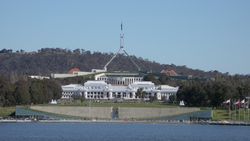
After World War II there was a shortage of housing and office space in Canberra, so a Senate Select Committee hearing was held in 1954 to address its development requirements. This Committee recommended the creation of a single planning body with executive power. Consequently, the NCPDC was replaced by the National Capital Development Commission in 1957. The NCDC oversaw the construction of Lake Burley Griffin and the completion of Griffin's Parliamentary Triangle in 1964. The population of Canberra increased by more than 50% every five years between 1955 and 1975. To accommodate the influx of residents, the NCDC oversaw the release of new residential land though the creation of new town centres: Woden opened in 1964, followed by Belconnen in 1966, Weston Creek in 1969 and Tuggeranong in 1973. A new National Library was constructed within the Parliamentary Triangle to be followed by the High Court of Australia, the National Gallery and finally a new Parliament House in 1988. The NCDC was disbanded in 1988, with most of its staff and planning authority transferred to the newly created ACT government and the new National Capital Authority, which was established to oversee Commonwealth interests in development of the national capital. Canberra has continued to grow with the further release of residential land in Gungahlin in the 1990s.
Development outside Canberra
A significant priority for the establishment of Canberra was the construction of water storage facilities. Cotter Dam was the first dam built on the Cotter River; construction on this 18.5 m high concrete gravity dam was started in 1912 and finished in 1915. Its height was raised to 31 m in 1951. Chlorination of Canberra's water began at the Cotter Dam in 1955; water treatment was moved to the Mt Stromlo Water Treatment Plant after 1967. Two additional dams were built on the Cotter: the Bendora Dam, a double-curvature, concrete-arch dam, was completed in 1961; and the Corin Dam, an earth and rock-fill embankment dam, was built in 1968. In 1979 Googong Dam, the biggest dam that supplies the ACT, was built on the Queanbeyan River in New South Wales.
Transport into and out of the ACT was also a priority for early development. In 1931 the Federal Highway linking the ACT to Goulburn was completed, and in 1936 an airfield was constructed at Duntroon. The only air disaster to occur in the ACT happened on 13 August 1940, when Australia's chief military officer and three senior ministers in the Menzies Government, James Fairbairn, Geoffrey Street and Henry Somer Gullett, were killed when their plane crashed on the southern approach to Canberra.
A railway connecting Canberra to Jervis Bay was planned, but never constructed. Several facilities were built in Jervis Bay including the Royal Australian Naval College (HMAS Creswell) built in 1913, the Jervis Bay Air Base Range, and a Botanic Gardens. In the 1970s a nuclear reactor and a large industrial development including a steelworks, petrochemical and chemical industry, aluminium smelting, copper refining, quarrying and woodchip industries were planned, but neither were developed.
The native forest of the ACT was almost wholly eucalypt species and provided a resource for fuel and domestic purposes, especially during the boom following World War II. By the early 1960s, logging had depleted the forests, and concern about water quality in the Cotter River catchment led to the forests being closed. Interest in forestry in the Territory had begun in 1915, when T.C.G. Weston had begun trials of a number of species including Pinus radiata on the slopes of Mt Stromlo. Plantation forestry began in earnest in 1926 with 2 km² planted annually around Uriarra and Pierce's Creek. By 1938 the area planted yearly was 4 km², with the favourable benefit of reducing erosion in the Cotter catchment. In 1967 the Australian Government approved a plan for a total 160 km² of plantation in the ACT, and by 1970 this goal had been achieved. The ease of access to the plantations has made them popular recreation areas for Canberrans. Throughout the 20th century, significant areas of plantation forest were periodically lost to bushfire, with major fires occurring in 1939, 1952, 1979, 1983, 2001 and 2003.
In 1936 about 8.1 km² of forest was set aside in order to create the Tidbinbilla Nature Reserve, and in 1939 a Koala enclose was built by the Institute of Anatomy. The government acquired land to establish a national park and fauna reserve in 1962, extending the park to 36.29 km² and later further increased to its current size of 54.50 km². In 1969 the first wildlife displays were created, and in 1971 the park was officially gazetted. In 1984 the Namadgi National Park was declared. The park is 1059 km² and makes up more than half of the Australian Capital Territory.
The Australian Government signed an agreement with the United States in 1960 for the establishment of satellite-tracking stations in the ACT. As a result of the agreement, three tracking stations were built in the ACT by NASA. The Canberra Deep Space Communication Complex was officially opened on 19 March 1965 by then Prime Minister Sir Robert Menzies, and is the only station still in operation in the ACT, communicating with interplanetary spacecraft. The Orroral Valley Tracking Station, which was for orbiting satellite support, opened in May 1965 in what is now part of Namadgi National Park, but was closed down in 1985. Honeysuckle Creek Tracking Station, completed in December 1966, was a communications relay station for Project Apollo, Skylab and interplanetary spacecraft between 1967 and 1981. In 1981 its 26 m antenna was moved to the Canberra Deep Space Communication Complex.
Government and the ACT
The Australian Capital Territory Police was created in 1927, the same year the federal government moved to the ACT, and initially consisted of only eleven officers. The size of the force grew over subsequent decades with the development of Canberra, and maintained similar status to that of police forces in other states until 1979. In that year, the ACT Police merged with the Commonwealth Police and the Federal Narcotics Bureau to form the Australian Federal Police, which were at the time responsible for law and order in Canberra. Since self-government was granted in 1988, the AFP has performed this under contract to the ACT government.
The ACT was given its first federal representation in 1949, when it gained a seat in the House of Representatives, the Division of Australian Capital Territory, under the 1948 Representation Act which increased the size of the House of Representatives. The ACT member could only vote on matters directly affecting the Territory. In 1974, the Australian Capital Territory and the Northern Territory were each allocated two Senate seats. In 1974, the House of Representatives seat was divided into two, the Division of Canberra and Division of Fraser. A third, the Division of Namadgi, was created in 1996, but was abolished in 1998 after an updated assessment of changes to the regional demographic distribution. Both House of Representatives seats have mostly been held by the Australian Labor Party, and the Senate seats have always been split one-to-one between the ALP and the Liberal Party of Australia.
From 1930, the ACT was administered by the ACT Advisory Council and the Minister for Territories, and from 1934 had its own Supreme Court. In 1974 the Council became a fully elected Legislative Assembly, advising the Department of the Capital Territory, and in 1979 this became a House of Assembly of 18 elected members. Despite a 1978 referendum, in which Canberrans rejected self government by 63% of the vote, the sitting ACT Assembly was dissolved in 1986. In December 1988, the ACT was granted full self-government with the passage of the Australian Capital Territory (Self-Government) Act 1988. The first elections were held in February 1989, and the inaugural 17-member Legislative Assembly moved into former public service buildings in London Circuit and Civic on May 11, 1989. The Australian Labor Party formed the ACT's first government, led by Chief Minister Rosemary Follett, who made history as Australia's first female head of government. When self-government was granted, the Jervis Bay Territory, which had been considered a part of the ACT, became a separate territory administered by the Minister for Territories. Since 1992, members of the Assembly have been elected by the Hare-Clark proportional representation system, which replaced the previously used modified D'Hondt method.
Whereas the ACT's federal electorates have been mainly held by Labor, the Liberal Party has been able to gain some footing in the ACT Assembly, and formed government in seven out of the Assembly's 17-year history (to 2006).
Since the 1993 creation of the National Native Title Tribunal, there have been four separate claims to Native Title lodged over alienated lands in the ACT by representatives of the Ngunnawal communities, in 1996, 1997, 1998 and 2002. The first two of these were discontinued after reaching a Federal Court hearing, and the third was rejected as not meeting applicable provisions. The fourth claim is still (as of 2005) active in seeking a resolution. In 2001, the ACT government entered into a cooperative agreement with the Ngunnawal community over the management of Namadgi National Park, which constitutes approximately 46% of the ACT's total land area. This agreement recognised the Ngunnawal's cultural association with the park's lands, and their role as custodians of their traditional lands and responsibilities to their ancestors and descendants for the protection of their sites. Management of the park is exercised in consultation with a group of appointed Ngunnawal representatives.
In the 1990s, a number of activities which are or were illegal in other Australian states were legalised in the ACT. These include the sale of X-rated pornographic materials (1989) and prostitution in brothels (1992), although brothels are only permitted to operate in the suburbs of Mitchell and Fyshwick. The personal use of cannabis was decriminalised in 1992 and abortion was decriminalised in 2002.
Recent history
The first years of the 21st century saw a period of extended drought in the ACT region, accompanied by several bushfires which caused widespread devastation. Over the 2001 Christmas period, five separate bushfires burnt over 16 km² of forest in the ACT, including millions of dollars' worth of plantation pine forest. The drought conditions continued during the following years, and in 2003 the ACT burned again. The 2003 bushfires damaged about 70% of the area of the ACT, including 99% of the Tidbinbilla Nature Reserve and significant areas of government-owned pine plantation. Four people were killed, 67 rural houses were destroyed, including 16 houses at Uriarra, 12 at Pierces Creek and 414 houses in the outer suburbs of Canberra. More than 200 other houses were damaged by the fires, and numerous buildings of historical significance were lost, including the Mt Franklin Chalet, which was built in 1937–38 for the Canberra Alpine Club and was the first club-built ski lodge in mainland Australia. Many other historic houses and huts in the Namadgi National Park were also lost. Nil Desperandum and Rock Valley Homestead, the two historic houses at Tidbinbilla, were destroyed. Another significant loss was the Mount Stromlo Observatory, operated by the Australian National University. The dome which housed the observatory's Oddie telescope was built in 1911 and was the first federal building in the ACT.


